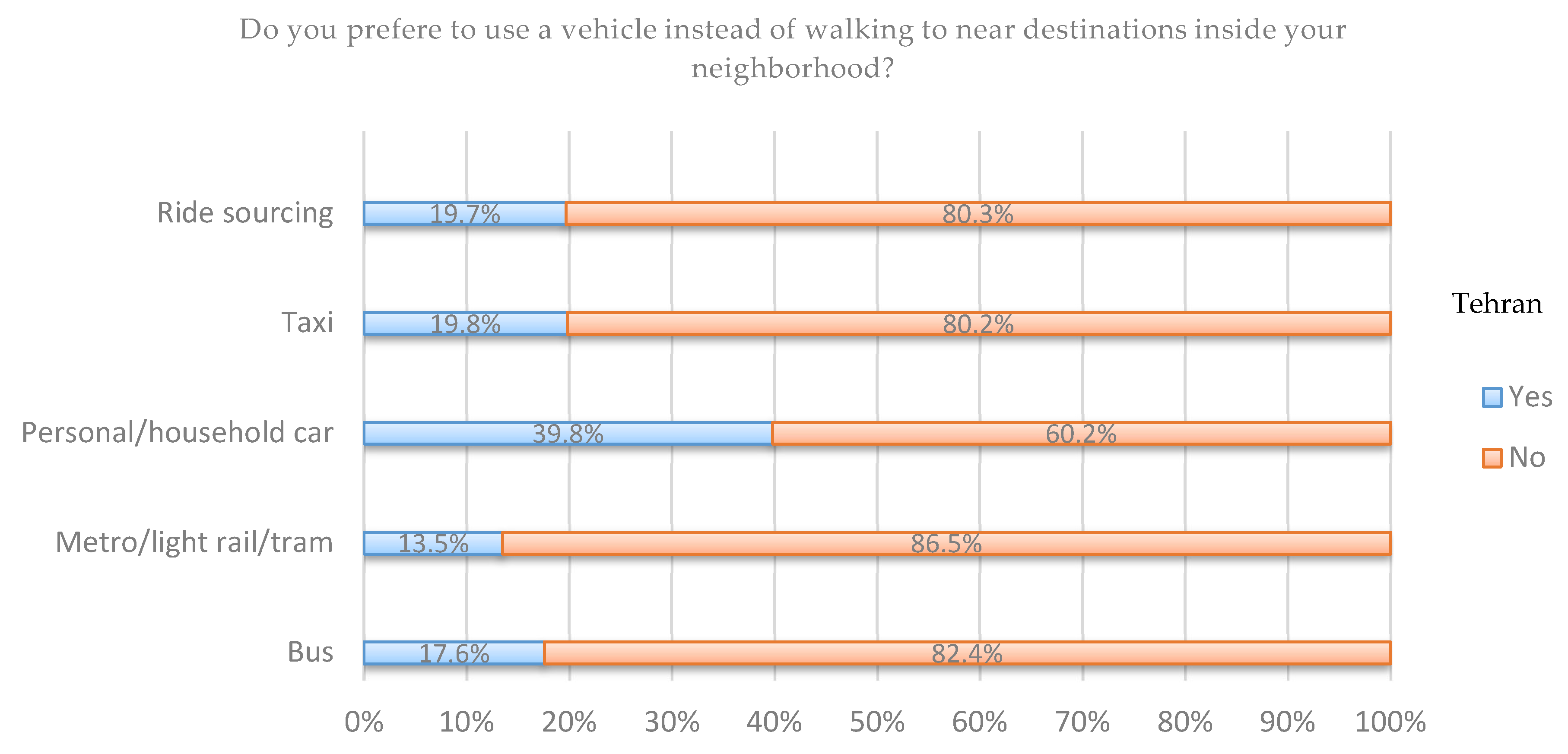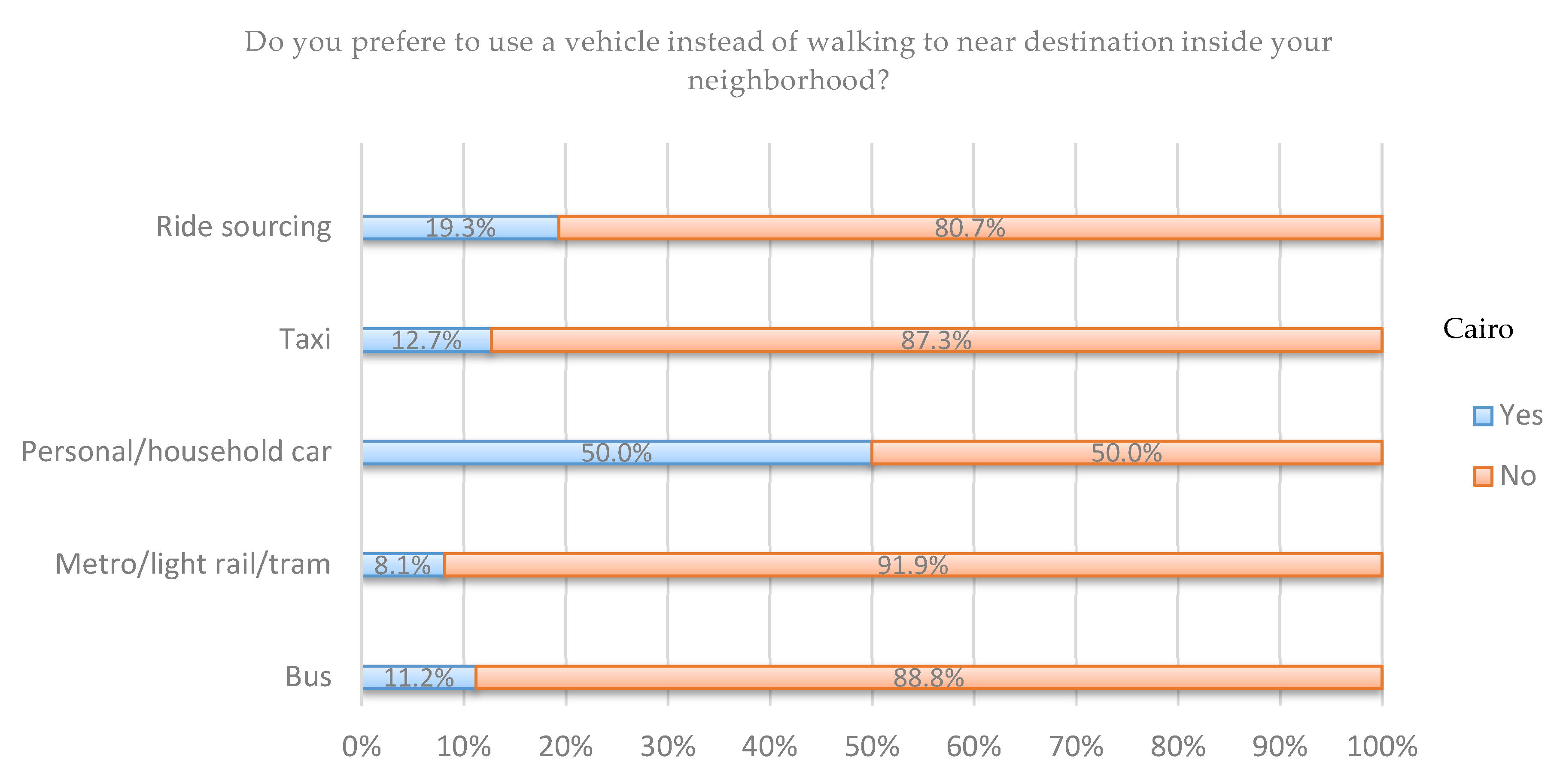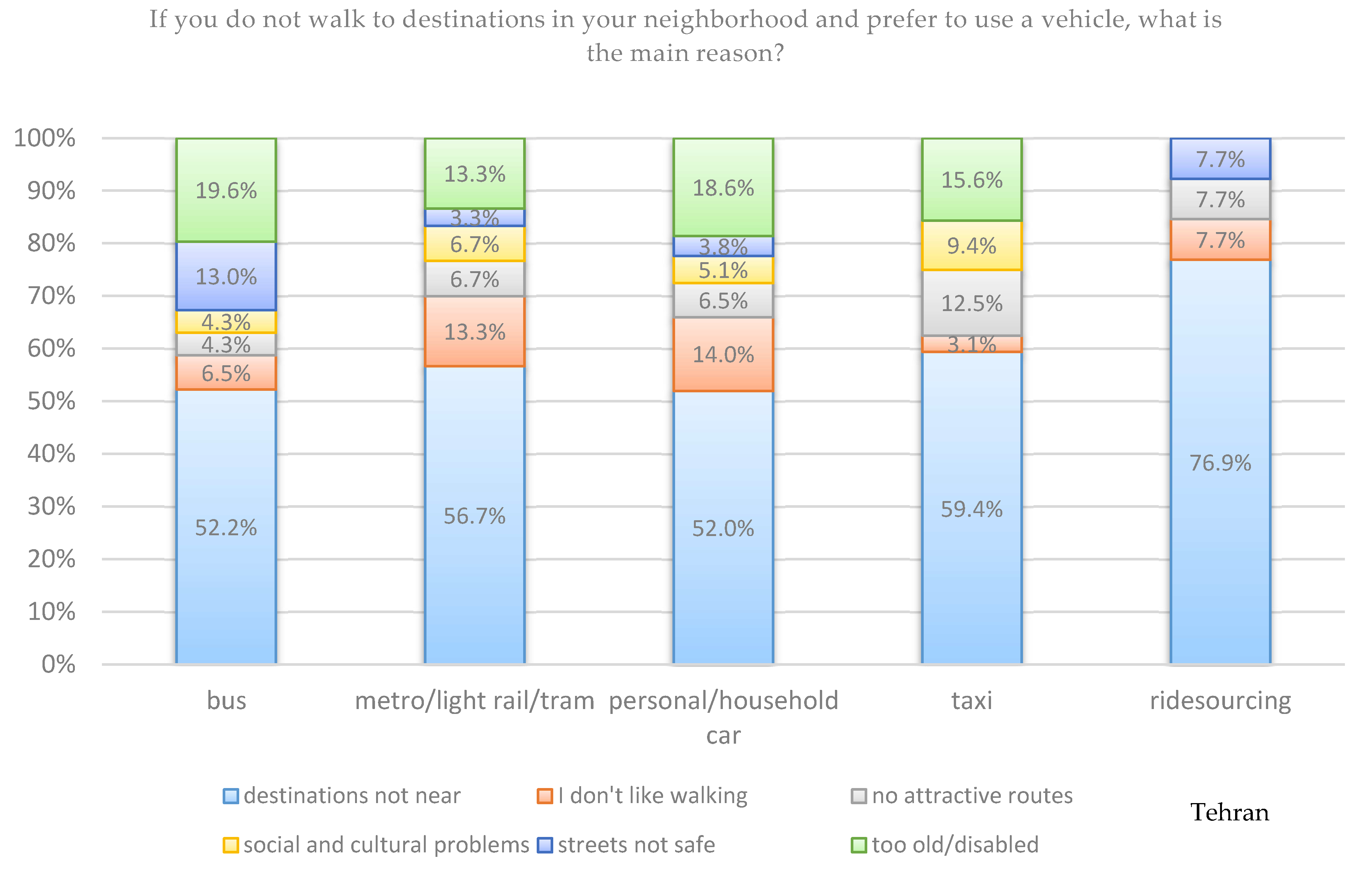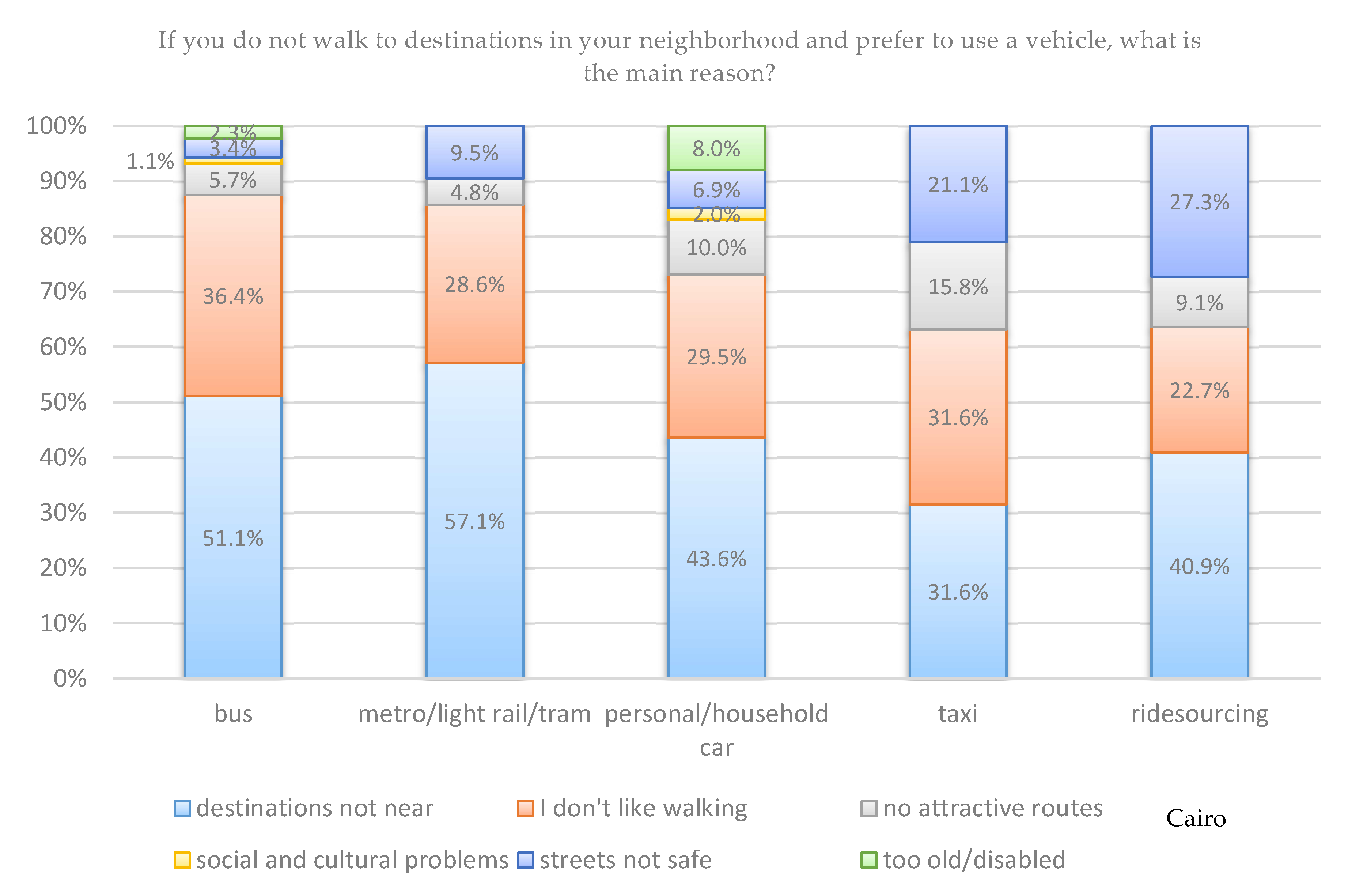The Association between Regular Use of Ridesourcing and Walking Mode Choice in Cairo and Tehran
Abstract
1. Introduction
2. Materials and Methods
2.1. Survey Design
- Intersection density (nodes/ha): This indicator quantifies the number of intersections per unit area in a 600m-catchment area of each respondent’s homes. Intersection density corresponds closely to block size in a neighborhood [29]. The greater intersection density indicates the smaller blocks, which means shorter walking distances and increases connectivity in the neighborhood.
- Link node ratio (%): The number of links (street segments) divided by nodes (street intersections) of the street network within the 600m-catchment area (based on the network) of each respondents’ home. The greater link node ratio shows better connectivity of the neighborhoods. This indicator shows how many paths are in the network per each node as different possible directions for walking. However, this indicator is unrelated to the size or spacing of the blocks or intersections in the neighborhoods [30].
2.2. Analysis Methods
3. Results
3.1. The Association between the Main Motorized Mode and Preference for not Walking
3.2. The Logistic Regression Models
3.3. Reasons for not Walking
- The destinations are not near my living place;
- There are no attractive and beautiful routes;
- The streets are not safe;
- There are social and cultural problems in the spaces near my living place;
- I do not like walking;
- It is slow/takes too much time.
4. Discussion
4.1. Regular Use of Ridesourcing and Walking Mode Choice
4.2. Socioeconomic Factors
4.3. Impact of Neighborhood Connectivity
4.4. Reasons for not Walking
5. Conclusions
Author Contributions
Funding
Acknowledgments
Conflicts of Interest
References
- Gössling, S. ICT and transport behaviour: A conceptual review. Int. J. Sustain. Trans. 2018, 12, 153–164. [Google Scholar] [CrossRef]
- Line, T.; Jain, J.; Lyons, G. The role of ICTs in everyday mobile lives. J. Trans. Geogr. 2011, 19, 1490–1499. [Google Scholar] [CrossRef]
- Rayle, L.; Shaheen, S.; Chan, N.; Dai, D.; Cervero, R. App-Based, On-Demand Ride Services: Comparing Taxi and Ridesourcing Trips and User Characteristics in San Francisco University of California Transportation Center. 2014. UCTC-FR-2014 08. Available online: http://citeseerx.ist.psu.edu/viewdoc/download?doi=10.1.1.662.707&rep=rep1&type=pdf (accessed on 26 May 2020).
- Rayle, L.; Dai, D.; Chan, N.; Cervero, R.; Shaheen, S. Just a better taxi? A survey-based comparison of taxis, transit, and ridesourcing services in San Francisco. Transp. Policy 2016, 45, 168–178. [Google Scholar] [CrossRef]
- Taylor, B.D.; Chin, R.; Crotty, M.; Dill, J.; Hoel, L.A.; Manville, M.; Polzin, S.; Schaller, B.; Shaheen, S.; Sperling, D.; et al. Between Public and Private Mobility: Examining the Rise of Technology-Enabled transportation Services; Special Report 319; Transportation Research Board: Committee for Review of Innovative Urban Mobility Services: Washington, DC, USA, 2015. [Google Scholar]
- Rietveld, P. Biking and Walking: The Position of Non-Motorized Transport Modes in Transport Systems, Tinbergen Institute Discussion Papers 01-111/3; Tinbergen Institute: Amsterdam, The Netherlands, 2001. [Google Scholar]
- Litman, T. Burwell Issues in sustainable transportation international. J. Glob. Environ. Issues 2006, 6, 331–347. [Google Scholar] [CrossRef]
- Frank, L.; Schmid, T.; Sallis, J.; Chapman, J.; Selens, B. Linking objectively measured physical activity with objectively measured urban form. Am. J. Prev. Med. 2005, 28, 117–125. [Google Scholar] [CrossRef] [PubMed]
- Frank, L.; Engelke, P. The Built Environment and Human Activity Patterns: Exploring the Impacts of Urban Form on Public Health. J. Plan. Literat. 2001, 16, 202–218. [Google Scholar] [CrossRef]
- Doorley, R.; Pakrashi, V.; Ghosh, B. Quantifying the health impacts of active travel: Assessment of methodologies. Transp. Rev. 2015, 35, 1–24. [Google Scholar] [CrossRef]
- Jarrett, J.; Woodcock, J.; Griffiths, U.K.; Chalabi, Z.; Edwards, P.; Roberts, I.; Haines, P. Effect of increasing active travel in urban England and Wales on costs to the National Health Service. Lancet 2012, 379, 2198. [Google Scholar] [CrossRef]
- Mueller, N.; Rojas-Rueda, D.; Cole-Hunter, T.; Nazelle, A.; Dons, E.; Gerike, R.; Götschi, T.; Panis, L.; Kahlmeier, S.; Nieuwenhuijsen, M. Health impact assessment of active transportation: A systematic review. Prev. Med. 2015, 76, 103–114. [Google Scholar] [CrossRef]
- SAE International, Taxonomy and definitions for terms related to shared mobility and enabling technologies. Available online: https://doi.org/10.4271/J3163_201809 (accessed on 21 June 2020).
- Hamdi, N.; Mourad, M.; Knecht, E.; Potter, M. Egypt Passes Law Regulating Uber, Careem Ride-Sharing Services. Available online: https://www.reuters.com/article/us-egypt-uber/egypt-passes-law-regulating-uber-careem-ride-sharing-services-idUSKBN1I81VG (accessed on 7 May 2018).
- Alkhalisi, Z.; Daftari, A. The Ride-Hailing App that Rules Tehran’s Busy Streets. Available online: https://money.cnn.com/2017/07/30/technology/iran-snapp-ride-hailing/ (accessed on 24 May 2020).
- The Guardian. Snapp: How Tehran’s Answer to Uber is Changing How People Travel, and Live. Available online: https://www.theguardian.com/cities/2017/jul/31/snapp-how-tehran-answer-to-uber-is-changing-how-people-travel-and-live (accessed on 24 May 2020).
- Chan, N.D.; Shaheen, S. Ridesharing in North America: Past, Present, and Future. Transp. Revs. 2012, 32, 93–112. [Google Scholar] [CrossRef]
- Firnkorn, J.; Müller, M. What Will Be the Environmental Effects of New Free-Floating Car-Sharing Systems? The Case of car2go in Ulm. Ecol. Econ. 2011, 70, 1519–1528. [Google Scholar] [CrossRef]
- Martin, E.W.; Shaheen, S. Greenhouse Gas Emission Impacts of Carsharing in North America. IEEE Trans. Intellig. Transport. Syst. 2011, 12, 1074–1086. [Google Scholar] [CrossRef]
- Elliot, M.; Susan, A.S.; Jeffrey, L. Impact of Carsharing on Household Vehicle Holdings: Results from North American Shared-Use Vehicle Survey. Transp. Res. Rec. 2010, 2143, 150–158. [Google Scholar] [CrossRef]
- Feigon, S.; Murphy, C. Shared Mobility and the Transformation of Public Transit; TCRP Research Report; Transportation Research Board: Washington, DC, USA, 2016; p. 188. [Google Scholar] [CrossRef]
- Circella, G.; Tiedeman, K.; Handy, S.; Alemi, F.; Mokhtarian, P. What Affects Millennials’ Mobility? Part I: Investigating the Environmental Concerns, Lifestyles, Mobility-Related Attitudes and Adoption of Technology of Young Adults in California; National Center for Sustainable Transportation: Davis, CA, USA, 2016; Available online: https://escholarship.org/uc/item/6wm51523 (accessed on 24 May 2020).
- Alemi, F.; Circella, G.; Handy, S.; Mokhtarian, P. What influences travelers to use Uber? Exploring the factors affecting the adoption of on-demand ride services in California. Travel Behav. Soc. 2018, 13, 88–104. [Google Scholar] [CrossRef]
- Masoumi, H.; Fruth, E. Transferring Urban Mobility Studies in Tehran, Istanbul, and Cairo to Other Large MENA Cities: Steps toward Sustainable Transport. Urban Dev. Issues 2020, 65, 27–44. [Google Scholar] [CrossRef]
- Bamberg, S.; Ajzen, I.; Schmidt, P. Choice of travel mode in the theory of planned behavior: The roles of past behavior, habit, and reasoned action. Basic Appl. Soc. Psychol. 2003, 25, 175–187. [Google Scholar] [CrossRef]
- Masoumi, H.; Gouda, A.A.; Layritz, L.; Stendera, P.; Matta, C.; Tabbakh, H.; Fruth, E. Urban Travel Behavior in Large Cities of MENA Region: Survey Results of Cairo, Istanbul, and Tehran. Available online: https://www.researchgate.net/publication/326175506_Urban_Travel_Behavior_in_Large_Cities_of_MENA_Region_Survey_Results_of_Cairo_Istanbul_and_Tehran (accessed on 24 May 2020).
- Kitamura, R.; Mokhtarian, P.; Daidet, L. A micro-analysis of land use and travel in five neighborhoods in the San Francisco Bay Area. Transportation 1997, 24, 125–158. [Google Scholar] [CrossRef]
- Frank, L.; Bradley, M.; Kavage, S.; Chapman, J.; Lawton, T.K. Urban Form, Travel Time and Cost Relationships with Tour Complexity and Mode Choice. Transportation 2008, 35, 37–54. [Google Scholar] [CrossRef]
- Bartholomew, K.; Ewing, R. Land Use–Transportation Scenarios and Future Vehicle Travel and Land Consumption: A Meta-Analysis. J. Am. Plan. Assoc. 2008, 75, 13–27. [Google Scholar] [CrossRef]
- Kuzmyak, J.R.; Kockelman, K.; Bowman, J.; Bradle, M.; Lawton, K.; Pratt, R.H. Estimating Bicycling and Walking for Planning and Project Development; Task 3 Interim Report; No. 08–78; NCHRP Project: Washington, DC, USA, 2011. [Google Scholar]
- Broach, J.; Dill, J.; Gliebe, J. Where do cyclists ride? A route choice model developed with revealed preference GPS data. Transp. Res. Part A Policy Pract. 2012, 46, 1730–1740. [Google Scholar] [CrossRef]
- Krizek, K.J.; Forsyth, A.; Baum, L. Walking and Cycling International Literature Review. Final Report. 2009. Available online:https://pdfs.semanticscholar.org/e552/b9f029b5f03842854c43e092d10f7581654d.pdf (accessed on 21 June 2020).
- Lamíquiz, P.J.; López-Domínguez, J. Effects of built environment on walking at the neighborhood scale. A new role for street networks by modeling their configurational accessibility? Transp. Res. 2015, 74, 148–163. [Google Scholar] [CrossRef]
- Yehua, D.W.; Weiye, X.; Ming, W.; Ran, W. Walkability, Land Use and Physical Activity. Sustainability 2016, 8, 65. [Google Scholar] [CrossRef]
- Wooldridge, J.M. Econometric Analysis of Cross Section and Panel Data; MIT Press: Cambridge, MA, USA, 2010. [Google Scholar]
- Pallant, J. SPSS Survival Manual: A Step by Step Guide to Data Analysis Using SPSS, 4th ed.; Allen & Unwin Book Publishers: Crows Nest, Australia, 2010. [Google Scholar]
- Hair, J.F.; Black, W.C.; Babin, B.J.; Anderson, R.E.; Tatham, R.L. Multivariate Data Analysis, 7th ed.; Pearson: New York, NY, USA, 2010. [Google Scholar]
- Etminani-Ghasrodashti, R.; Ardeshiri, M. Modeling travel behavior by the structural relationships between lifestyle, built environment and non-working trips. Transport. Res. Pol. Pract. 2015, 78, 506–518. [Google Scholar] [CrossRef]
- Etminani-Ghasrodashti, R.; Ardeshiri, M. The impacts of built environment on home-based work and non-work trips: An empirical study from Iran. Transport. Res. Pol. Pract. 2016, 85, 196–207. [Google Scholar] [CrossRef]
- Shahangian, R.; Kermanshah, M.; Mokhtarian, P.L. Gender differences in response to policies targeting commute to automobile-restricted central business district. J. Transp Res. Board. 2012, 2320, 80–89. [Google Scholar] [CrossRef]
- Al-Atawi, A.; Saleh, W. Travel behavior in Saudi arabia and the role of social factors. Transport 2014, 29, 269–277. [Google Scholar] [CrossRef]
- Danaf, M.; Abou-Zeid, M.; Kaysi, I. Modeling travel choices of students at a private, urban university: Insights and policy implications. Case Stud. Transport Pol. 2014, 2, 142–152. [Google Scholar] [CrossRef]
- Handy, S.; Cao, X.; Mokhtarian, P. Correlation or Causality between the Built Environment and Travel Behavior? Evidence from Northern California. Transp. Res. Part D 2005, 10, 427–444. [Google Scholar] [CrossRef]
- Soltani, A.; Esmaeili-Ivaki, Y. The Influence of Urban Physical Form on Trip Generation, Evidence from Metropolitan Shiraz, Iran. Indian J. Sci. Technol. 2011, 4, 1168–1174. [Google Scholar] [CrossRef]
- Masoumi, H. A discrete choice analysis of transport mode choice causality and perceived barriers of sustainable mobility in the MENA region. Transp. Policy 2019, 79, 37–53. [Google Scholar] [CrossRef]
- Hampshire, R.; Simek, C.; Fabusuyi, T.; Di, X.; Chen, X. Measuring the impact of an unanticipated suspension of ridesourcing in Austin, Texas. 2017. Available online: http://dx.doi.org/10.2139/ssrn.2977969 (accessed on 24 May 2020).
- Clewlow, R.; Mishra, G. Disruptive Transportation: The Adoption, Utilization, and Impacts of Ride-Hailing in the United States. Institute of Transportation Studies, University of California, Davis, 2017, Research Report UCD-ITS-RR-17-07. Available online: https://itspubs.ucdavis.edu/wp-content/themes/ucdavis/pubs/download_pdf.php?id=2752 (accessed on 24 May 2020).
- Henao, A.; Marshall, W.E. The Impact of Ride-Hailing on Vehicle Miles Traveled. Transportation 2018. [Google Scholar] [CrossRef]
- Circella, G.; Alemi, F. Transport Policy in the Era of Ride hailing and Other Disruptive Transportation Technologies. Advances in Transport Policy and Planning. 2018, pp. 119–144. Available online: http://transp-or.epfl.ch/heart/2018/abstracts/5400.pdf (accessed on 28 May 2020).
- Lee, K.; Qianran, J.; Animesh, A.; Ramaprasad, J. Are Ride-Hailing Services Sustainable? the Impact of Uber on the Transportation Mode Choices of Drivers, Riders, and Walkers. Riders Walkers 2019. [Google Scholar] [CrossRef]
- Henao, A. Impacts of Ride sourcing-Lyft and Uber-on Transportation Including VMT, Mode Replacement, Parking, and Travel Behavior. Ph.D. Thesis, Department of Civil and Environmental Engineering, University of Colorado at Denver, Denver, CO, USA, 2017. [Google Scholar]
- Rizk, N.; Salem, N.; Weheba, N. A Gendered Analysis of Ridesharing: Perspectives from Cairo, CIPPEC publications, Egypt. 2018. Available online: http://www.cippec.org/wp-content/uploads/2018/09/UrbanTransport-completo-web_CIPPEC.pdf (accessed on 21 May 2020).
- IFC; Accenture; Uber. Driving Toward Equality: Women, Ride-Hailing and the Sharing Economy (Rep.). 2018. Available online: https://www.ifc.org/wps/wcm/connect/topics_ext_content/ifc_external_corporate_site/gender+at+ifc/drivingtowardequality (accessed on 21 May 2020).
- Dzisi, E.; Ackaah, W.; Aprimah, B.; Adjei, E. Understanding demographics of ridesourcing and the factors that underlie its use among young people. Sci. Afr. 2020, 7, e00288. [Google Scholar] [CrossRef]
- Feigon, S.; Colin, M. Broadening Understanding of the Interplay Between Public Transit, Shared Mobility, and Personal Automobiles; Pre-publication draft of TCRP Research, 2018, Report 195; Transportation Research Board: Washington, DC, USA, 2018. [Google Scholar]
- Conway, M.W.; Salon, D.; King, D.A. Trends in Taxi Use and the Advent of Ridehailing, 1995-2017: Evidence from the US National Household Travel Survey. Urban Sci. 2018, 2, 79. [Google Scholar] [CrossRef]
- Ewing, R.; Cervero, R. Travel and the Built Environment: A Meta-Analysis. J. Am. Plan. Assoc. 2010, 76, 265–294. [Google Scholar] [CrossRef]
- Reilly, M.K.; Landis, J. Influence of Urban form and Land Use on Mode Choice: Evidence from the 1996 Bay Area Travel Survey; TRB: Washington, DC, USA, 2002. [Google Scholar]
- Cervero, R.; Radisch, C. Travel choices in pedestrian versus automobile oriented neighborhoods. Transp. Policy 1995, 3, 127–141. [Google Scholar] [CrossRef]
- Shbeeb, L.; Awad, W. Walkability of School Surroundings and its Impacts on Pedestrian Behavior, TeMA. J. Land Use Mobil. Environ. 2013, 6, 171–188. [Google Scholar]
- Özbil, A.; Argin, G.; Yesiltepe, D. Pedestrian route choice by elementary school students: The role of street network configuration and pedestrian quality attributes in walking to school. Int. J. Design Creat. Innov. 2016, 4, 67–84. [Google Scholar] [CrossRef]
- Arabani, M.; Amani, B. Evaluating the Parameters Affecting Urban Trip-Generation. Iran. J. Sci. Technol. Trans. B Eng. 2007, 31, 547–560. [Google Scholar]
- Soltani, A.; Shams, A. Analyzing the influence of neighborhood development pattern on modal choice. J. Adv. Transp. 2017, 2017. [Google Scholar] [CrossRef]




| Tehran Total N = 2377 | Public Bus N = 262 | Metro/Light Rail/Tram N = 222 | Personal/Household Car N = 1665 | Traditional Taxi N = 162 | Ridesourcing N = 66 | ||||||
|---|---|---|---|---|---|---|---|---|---|---|---|
| N | % | N | % | N | % | N | % | N | % | ||
| Age | <25 | 65 | 24.80 | 72 | 32.40 | 187 | 11.20 | 37 | 22.80 | 6 | 9.10 |
| 25 ≤ Age ≤ 45 | 114 | 43.50 | 93 | 41.90 | 1012 | 60.80 | 97 | 59.90 | 43 | 65.20 | |
| 45 < Age ≤ 60 | 53 | 20.20 | 38 | 17.10 | 380 | 22.80 | 25 | 15.40 | 12 | 18.20 | |
| 60 < Age | 30 | 11.50 | 19 | 8.60 | 86 | 5.20 | 3 | 1.90 | 5 | 7.60 | |
| Gender | Female | 160 | 61.10 | 121 | 54.50 | 792 | 47.60 | 91 | 56.20 | 40 | 60.60 |
| Male | 102 | 38.90 | 101 | 45.50 | 873 | 52.40 | 71 | 43.80 | 26 | 39.40 | |
| Activity Work or Study | No | 142 | 54.20 | 98 | 44.10 | 421 | 25.30 | 49 | 30.20 | 27 | 40.90 |
| Yes | 120 | 45.80 | 124 | 55.90 | 1244 | 74.70 | 113 | 69.80 | 39 | 59.10 | |
| Having household car | No | 96 | 36.60 | 84 | 37.80 | 0 | 0 | 21 | 13 | 0 | 0 |
| Yes | 166 | 63.40 | 138 | 62.20 | 1665 | 100 | 141 | 87 | 66 | 100 | |
| Having driving license | No | 144 | 55.00 | 109 | 49.10 | 211 | 12.70 | 58 | 35.80 | 19 | 28.80 |
| Yes | 118 | 45.00 | 113 | 50.90 | 1454 | 87.30 | 104 | 64.20 | 47 | 71.20 | |
| M | Mdn | M | Mdn | M | Mdn | M | Mdn | M | Mdn | ||
| Household income | Euro | 1002 | 935 | 1141 | 935 | 1435 | 1169 | 1275 | 1169 | 2165 | 1403 |
| Living cost | Euro | 824 | 701 | 909 | 818 | 1151 | 1052 | 1064 | 1028 | 1344 | 1169 |
| Income-cost ratio | 1.32 | 1.09 | 1.26 | 1.12 | 1.28 | 1.17 | 1.22 | 1.14 | 1.57 | 1.17 | |
| Cairo Total N = 2011 | Public Bus N = 789 | Metro/Light Rail/Tram N = 260 | Personal/Household Car N = 698 | Traditional Taxi N =150 | Ridesourcing N = 114 | ||||||
|---|---|---|---|---|---|---|---|---|---|---|---|
| N | % | N | % | N | % | N | % | N | % | ||
| Age | < 25 | 225 | 28.5 | 84 | 32.3 | 129 | 18.5 | 35 | 23.3 | 48 | 42.1 |
| 25 ≤ Age ≤ 45 | 422 | 53.5 | 119 | 45.8 | 389 | 55.7 | 62 | 41.3 | 58 | 50.9 | |
| 45 < Age ≤ 60 | 114 | 14.4 | 43 | 16.5 | 148 | 21.2 | 40 | 26.7 | 8 | 7.0 | |
| 60 < Age | 28 | 3.5 | 14 | 5.4 | 32 | 4.6 | 13 | 8.7 | 0 | 0.0 | |
| Gender | Female | 359 | 45.5 | 113 | 43.5 | 198 | 28.4 | 79 | 52.7 | 73 | 64.0 |
| Male | 430 | 54.5 | 147 | 56.5 | 500 | 71.6 | 71 | 47.3 | 41 | 36.0 | |
| Activity Work or Study | No | 238 | 30.2 | 75 | 28.8 | 104 | 14.9 | 63 | 42.0 | 36 | 31.6 |
| Yes | 551 | 69.8 | 185 | 71.2 | 594 | 85.1 | 87 | 58.0 | 78 | 68.4 | |
| Having Household Car | No | 432 | 54.8 | 175 | 67.3 | 0 | 0 | 49 | 32.7 | 0 | 0 |
| Yes | 357 | 45.2 | 85 | 32.7 | 698 | 100 | 101 | 67.3 | 114 | 100 | |
| Having driving license | No | 619 | 78.5 | 206 | 79.2 | 84 | 12.0 | 107 | 71.3 | 84 | 73.7 |
| Yes | 170 | 21.5 | 54 | 20.8 | 614 | 88.0 | 43 | 28.7 | 30 | 26.3 | |
| M | Mdn | M | Mdn | M | Mdn | M | Mdn | M | Mdn | ||
| Household income | Euro | 5355 | 5000 | 4943 | 4600 | 9597 | 8000 | 6530 | 6000 | 11,362 | 9000 |
| Living Cost | Euro | 4960 | 4500 | 4510 | 4000 | 7692 | 7000 | 5765 | 5500 | 9298 | 8000 |
| Income-cost ratio | 1.10 | 1.00 | 1.09 | 1.00 | 1.22 | 1.10 | 1.14 | 1.00 | 1.18 | 1.11 | |
| Tests | Cairo | Tehran |
|---|---|---|
| Omnibus Tests of Model Coefficients | ||
| Chi-square | 466.304 | 265.481 |
| p-value | <0.001 | <0.001 |
| −2 Log likelihood | 1773.064 | 2202.462 |
| Nagelkerke R Square | 0.309 | 0.180 |
| Overall percentage of correct prediction | 79.4% | 71.8% |
| City | Tehran | Cairo | |||||||
|---|---|---|---|---|---|---|---|---|---|
| B | S.E. | p value | Exp(B) | B | S.E. | p value | Exp(B) | ||
| Main motorized mode | <0.001 | <0.001 | |||||||
| Public bus | 0.325 | 0.469 | 0.488 | 1.40 | −0.719 | 0.278 | 0.010 | 0.49 | |
| Metro/light rail | −0.272 | 0.484 | 0.575 | 0.76 | −1.136 | 0.348 | 0.001 | 0.32 | |
| Personal/Household car | 1.017 | 0.430 | 0.018 | 2.76 | 0.888 | 0.277 | 0.001 | 2.43 | |
| Taxi | 0.403 | 0.482 | 0.403 | 1.50 | −0.457 | 0.356 | 0.199 | 0.63 | |
| Employee/student | Yes = 1, No = 0 | 1.417 | 0.192 | <0.001 | 4.12 | 0.923 | 0.177 | <0.001 | 2.52 |
| Gender | Female = 1, Male = 0 | 0.148 | 0.105 | 0.159 | 1.16 | 0.307 | 0.141 | 0.029 | 1.36 |
| Having a driver license | Yes = 1, No = 0 | 1.007 | 0.166 | <0.001 | 2.74 | 0.828 | 0.197 | <0.001 | 2.29 |
| Household income/cost ratio | 0.134 | 0.065 | 0.040 | 1.14 | 0.773 | 0.168 | <0.001 | 2.17 | |
| Freq work/study trip | No. per week | −0.081 | 0.011 | <0.001 | 0.92 | 0.003 | 0.009 | 0.777 | 1.00 |
| Link node ratio | Percent of nodes/hectare | 0.008 | 0.004 | 0.052 | 1.00 | −0.037 | 0.006 | <0.001 | 0.96 |
| Intersection density | nodes/hectare | 0.031 | 0.035 | 0.379 | 1.03 | −0.178 | 0.045 | <0.001 | 0.84 |
| Constant | −4.338 | 0.919 | <0.001 | 0.01 | 3.097 | 1.142 | 0.007 | 22.14 | |
© 2020 by the authors. Licensee MDPI, Basel, Switzerland. This article is an open access article distributed under the terms and conditions of the Creative Commons Attribution (CC BY) license (http://creativecommons.org/licenses/by/4.0/).
Share and Cite
Mostofi, H.; Masoumi, H.; Dienel, H.-L. The Association between Regular Use of Ridesourcing and Walking Mode Choice in Cairo and Tehran. Sustainability 2020, 12, 5623. https://doi.org/10.3390/su12145623
Mostofi H, Masoumi H, Dienel H-L. The Association between Regular Use of Ridesourcing and Walking Mode Choice in Cairo and Tehran. Sustainability. 2020; 12(14):5623. https://doi.org/10.3390/su12145623
Chicago/Turabian StyleMostofi, Hamid, Houshmand Masoumi, and Hans-Liudger Dienel. 2020. "The Association between Regular Use of Ridesourcing and Walking Mode Choice in Cairo and Tehran" Sustainability 12, no. 14: 5623. https://doi.org/10.3390/su12145623
APA StyleMostofi, H., Masoumi, H., & Dienel, H.-L. (2020). The Association between Regular Use of Ridesourcing and Walking Mode Choice in Cairo and Tehran. Sustainability, 12(14), 5623. https://doi.org/10.3390/su12145623







